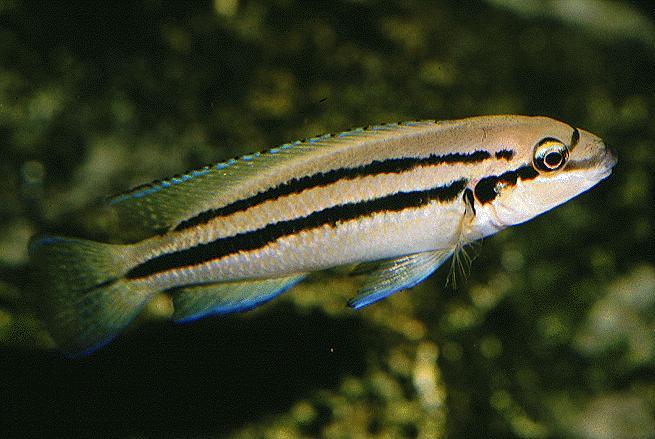
In the hobby, the genus Chalinochromis takes a back seat to Julidochromis in popularity. It’s hard to see why after keeping and spawning these small, relatively peaceful fish. Fish of the genus Chalinochromis are very similar to Julidochromis in body type, with long, thin bodies. They tend to have a white background color over which dark markings may be present depending on the particular species. One of the distinguishing traits of the genus is the presence of small wart-like structures on their lips. These structures may be an adaptation for eating, helping them root out tiny sponges and invertebrates in the small rock crevices in which they live and feed. However, no one is certain exactly what purpose these structures serve. Sp. ‘Ndobnoi’ is characterized by dotted lines on the body rather than stripes found on many of the other Chalinochromis species, and its white background color has a faint pinkish glow. Its known range is the east coast of Lake Tanganyika between Kasjoe and Bulu point around Karlani island. Basically, that’s the central part of Tanzania’s Tanganyikan coast.
Aquarium care is, as far as I can tell, exactly the same as dwarf or mid-sized Julies: a tank with a lot of rockwork and hiding spaces, and maybe some dither fish to coax them out of their caves. I kept my group of eight in a 30 gal aquarium with gravel, and lava rock, and a few clay pots. The water was pH 8.5, hardness 350ppm. I changed 50% of the water every other week. I got this batch as juveniles. Actually, these fish presented fewer problems than Julies in that they were not nearly as aggressive. One nasty part of Julies for me is that they seem to live together great until they start pairing off. Then suddenly they begin to assassinate each other. This can happen overnight. For many pair bond fish, you can spot a weak one at the top or see it being chased before a severe beat-down occurs, but Julies seem to pick a fish out a kill it in a few hours. Rarely have I gotten a batch to Julies to pair off without taking some casualties. Chalinochromis “Ndobnoi” surprised me in that the dominant fish were perfectly happy to spawn in the presence of the weaker fish. Of course, the weaker fish had to keep to the upper regions of the tank, and spent most of their day “getting out of the way”, but they never lost scales or fins.
Interestingly, the strong male seemed to keep two females, each in a different rock pile, and constantly visited each pile through the day. This type of behavior is probably a result of the artificial environment of the aquarium rather than a natural breeding mode. It was hard to tell when spawning occurred. The females would keep to their rock piles more and excavate more gravel beneath them. Fry appeared slowly, in batches of two or three and never built up numbers quickly. The tops I got in the tank just leaving them with the parents were only a dozen or so. This could account for their lack of wider popularity. My group was richly fed on mosquito larvae, blood worms and flake rotated during twice-daily feedings. The babies were fed artemia once they appeared.
Leave a Reply